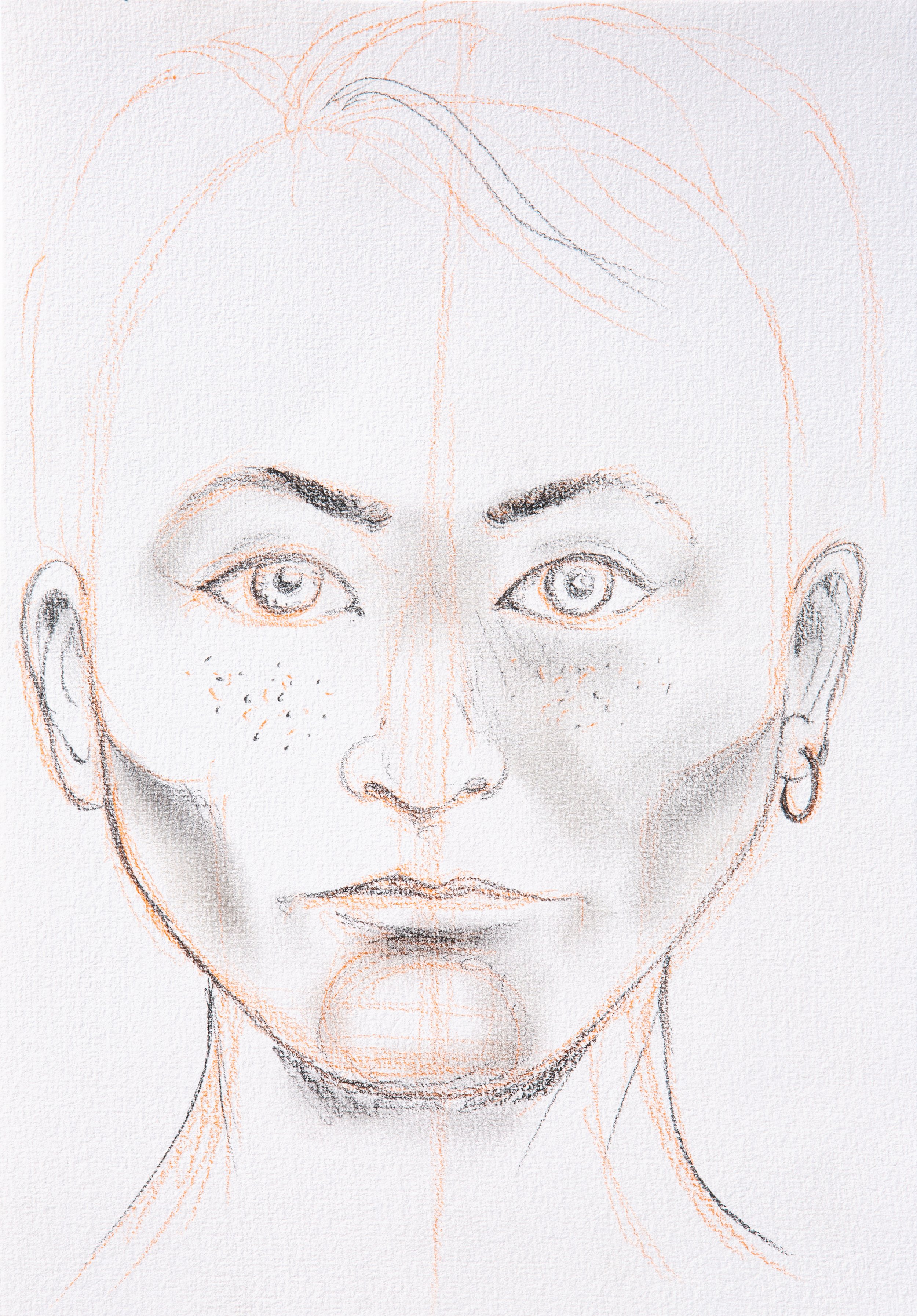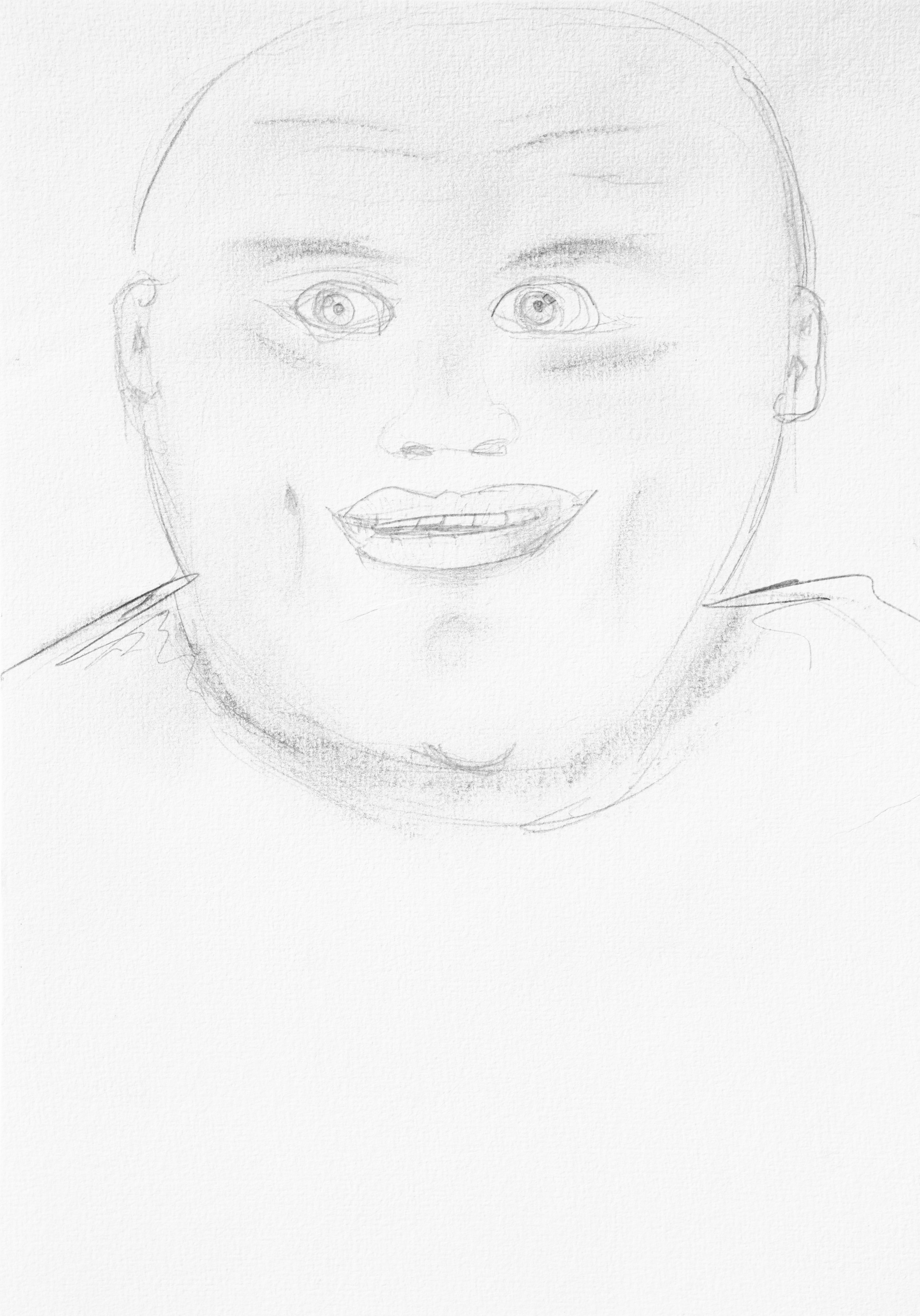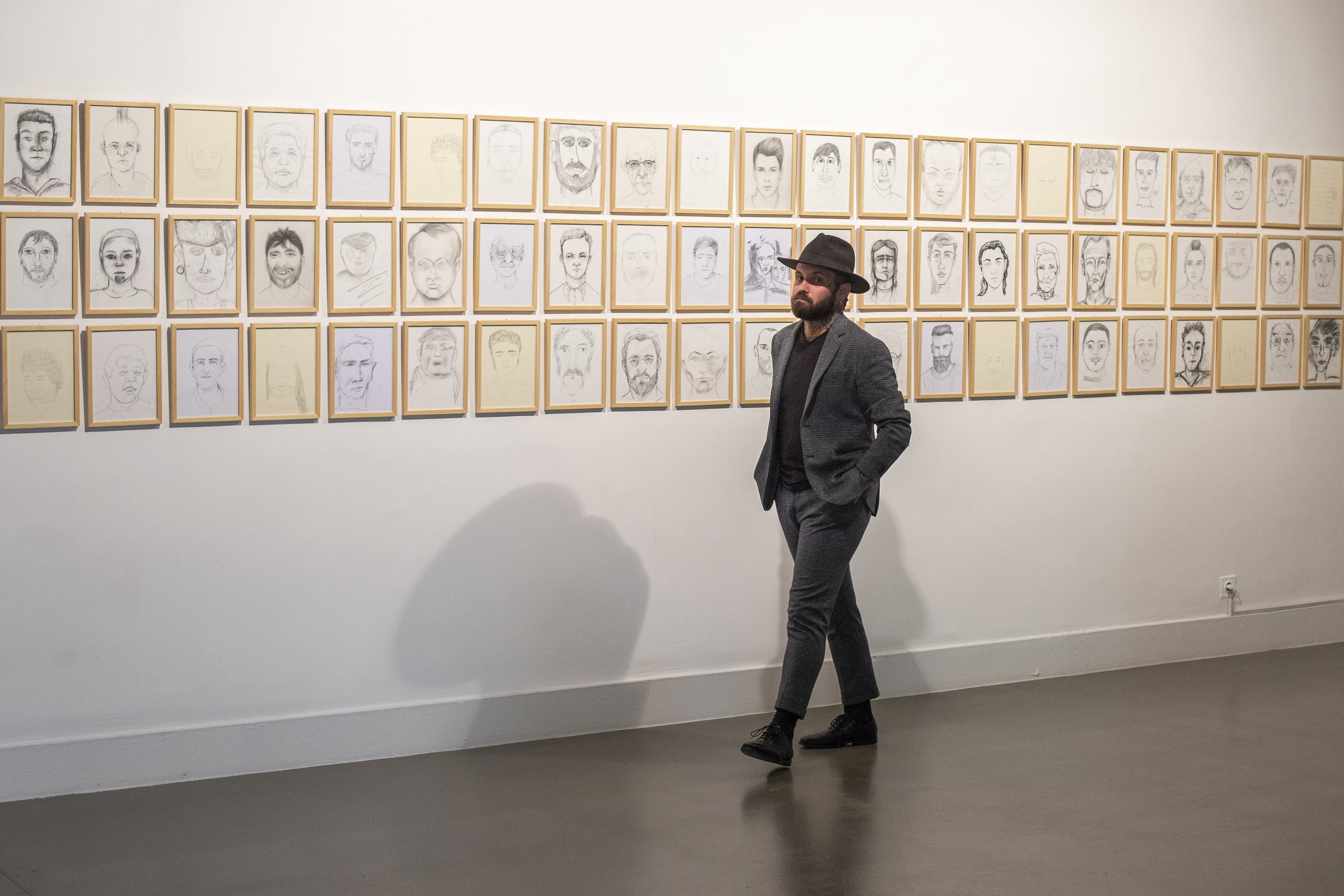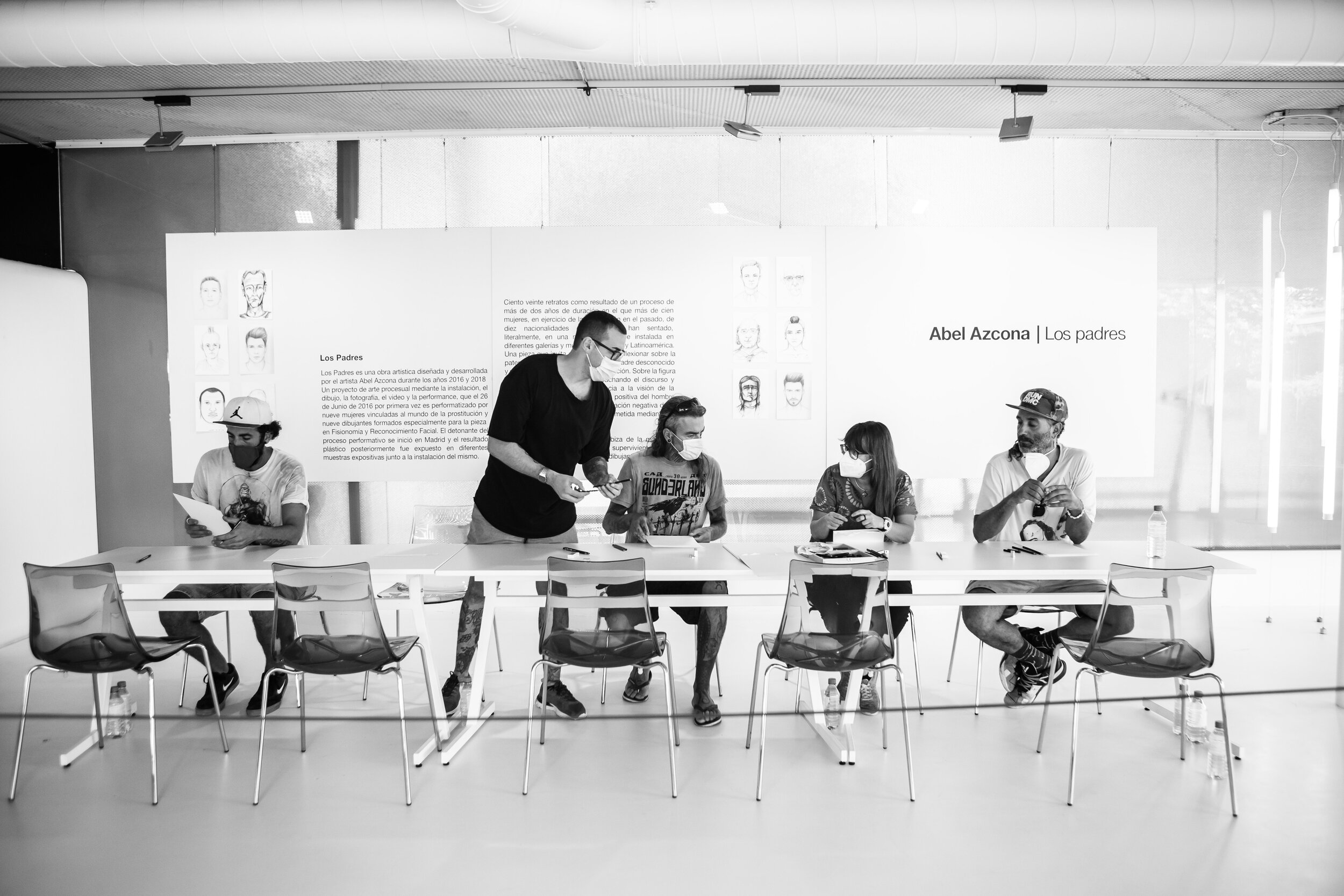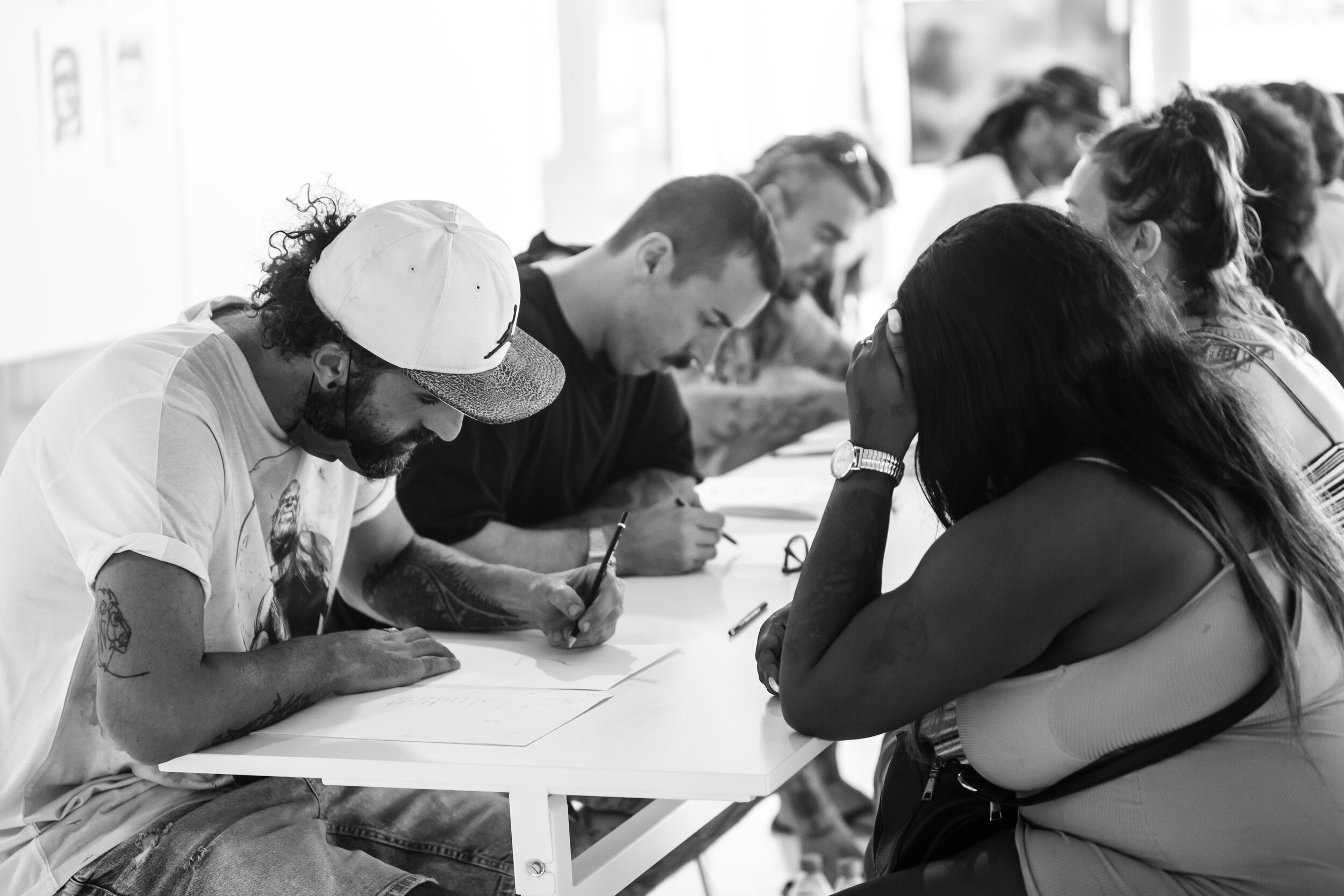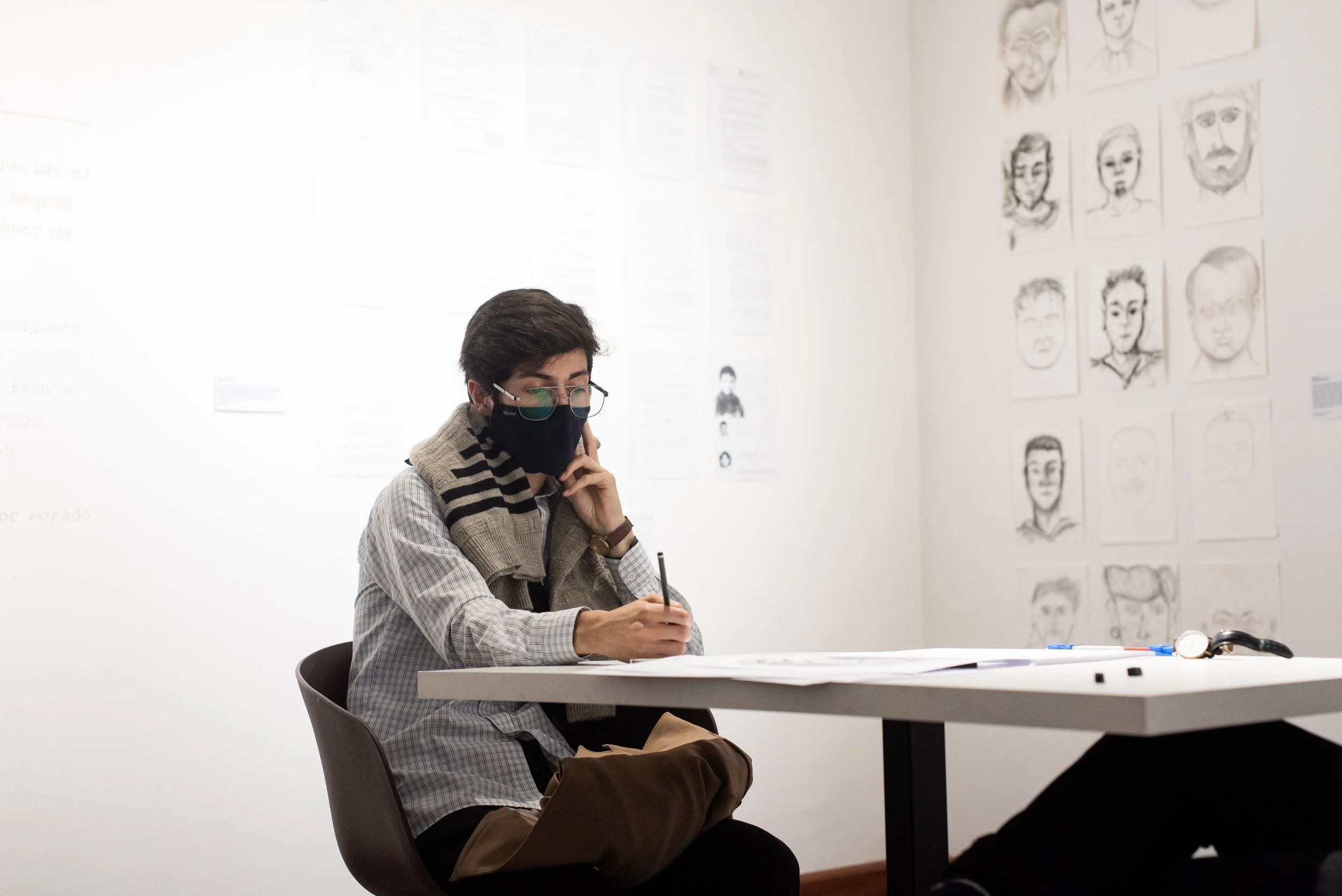Video of the original performance "The Fathers" by Abel Azcona in June 2016 and video of the opening of the exhibition with live performance in June 2017 in Madrid. / Video performancel “Los Padres” de Abel Azcona en junio de 2016 y video de la inauguración de la exposición con performance en vivo en junio de 2017 en Madrid.
“I have not known the feeling of family.”
“Yo no he conocido nunca el sentimiento de familia.”
The Fathers is an artistic work designed and developed by artist Abel Azcona during the years 2016 and 2021. A processual art project through installation, drawing, photography, video and performance, which was performed for the first time on June 26, 2016 by by nine women linked to the world of prostitution and nine drafstman specially trained in Physiognomy and Facial Recognition for the piece. The trigger for the performative process began in Madrid and the plastic result was later exhibited in different exhibition shows together with its installation.
One hundred and twenty portraits as a result of a process that lasted more than two years, in which more than one hundred women who had practiced prostitution in the past, of ten different nationalities, have sat at an endless table installed in different galleries and museums in Spain and Latin America. A piece that invites the viewer to reflect on paternity, in the case of Azcona, an unknown father and a mother in the practice of prostitution. About the figure of the prostitute and the whoremonger, to listen to their speech and description. A denunciation of the vision of society regarding the positive appreciation of the men who consume prostitution, and the negative assessment of the prostitute who is frequently subdued through an economic exchange.
At the beginning of the performative phase, the viewer was able to attend live the training of nine fine arts graduates by an expert physiognomist and trainer of facial recognition technicians. In the second performative phase, the nine cardrafstman were integrated into the living installation designed by the artist together with nine women with experiences in the field of prostitution and trafficking.
In an intimate relationship, each drawer interviewed one of the ex-prostitutes as a witness, and they physically described the man who, through payment, established their last sexual relationship, in a prostitution exchange. During the conversation, viewers were able to see live how the drawers were translating the description of the clients onto a blank paper.
A face-to-face encounter between each physiognomist and each woman. Each encounter resulted in a descriptive portrait of the man who paid for sexually employing each of those women.
They are the protagonists of the performative process, being heard by the portraitists, and between them both looking for the face that represents more than 50% of men in Spain, who have used and paid for prostitution relationships.
They and the portraitists left the installation, but the portraits of each of the men described remained on the wooden table. Some portraits that later formed the exhibition of the The Fathers project. One hundred and twenty drawings with faces emerged from the real stories of the protagonists.
Making visible and showing the faces of the parents, representants the patriarchy and in a more personal standpoint representing Azcona's father, or many parents.
Los Padres es una obra artística diseñada y desarrollada por el artista Abel Azcona durante los años 2016 y 2021. Un proyecto de arte procesual mediante la instalación, el dibujo, la fotografía, el video y la performance, que el 26 de Junio de 2016 por primera vez es performatizado por nueve mujeres vinculadas al mundo de la prostitución y nueve dibujantes formados especialmente para la pieza, en Fisionomía y Reconocimiento Facial. El detonante del proceso performativo se inició en Madrid y el resultado plástico posteriormente fue expuesto en diferentes muestras expositivas junto a la instalación del mismo.
Ciento veinte retratos como resultado de un proceso de más de dos años de duración en el que más de cien mujeres, en ejercicio de la prostitución en el pasado, de diez nacionalidades diferentes se han sentado, literalmente, en una mesa interminable instalada en diferentes galerías y museos de España y Latinoamérica. Una pieza que invita al espectador a reflexionar sobre la paternidad, en el caso de Azcona, un padre desconocido y una madre en ejercicio de la prostitución. Sobre la figura de la prostituta y el putero, escuchando el discurso y descripción de ellas. Una denuncia a la visión de la sociedad en cuanto a la valoración positiva del hombre que consume prostitución, y la valoración negativa de la prostituta que frecuentemente es sometida mediante un intercambio económico.
En el inicio de la fase performativa el espectador pudo asistir en vivo a la formación de nueve licenciados en bellas artes por un experto fisionomista y preparador de técnicos en reconocimiento facial. En la segunda fase performativa los nueve dibujantes se integraron en la instalación viva diseñada por el artista junto a nueve mujeres con experiencia en el ámbito de la prostitución y la trata.
En una relación de intimidad, cada dibujante entrevistó como testigo a una de las exprostitutas, y ellas describieron físicamente al hombre que mediante pago estableció su última relación sexual, en un intercambio de prostitución. Durante la conversación, los espectadores pudieron comprobar en directo como los dibujantes iban plasmando la descripción de los clientes en un papel en blanco.
Un encuentro cara a cara entre cada fisionomista y cada mujer. De cada encuentro como resultado un retrato descriptivo del hombre que pagó por emplear sexualmente a cada una de aquellas mujeres. Ellas protagonistas del proceso performativo, siendo escuchadas por los retratistas, y entre ambos buscando el rostro que representa a más del 50 % de hombres en España, que han utilizado y pagado por relaciones de prostitución. Ellas y los retratistas abandonaron la instalación, pero encima de la mesa de madera quedaron los retratos de cada uno de los hombres descritos. Unos retratos que posteriormente formaron la exposición del proyecto Los Padres. Ciento veinte dibujos con rostros surgidos desde la historias reales de las protagonistas. Visibilizando y mostrando los rostros de los padres, en representación del patriarcado desde una idea global y en representación desde una visión más personal del padre de Azcona, o de muchos padres.
The work The Parents at the La Panera Art Center in Lleida. / La obra de “Los padres” en el Centro de Arte La Panera de Lleida.
The work The Parents at the Sala Amós Salvador in Logroño. / La obra de “Los padres” en la Sala Amós Salvador en Logroño.
Los Padres, Abel Azcona. - Fotografía, Video, Performance y Objeto. 2016-2021. Obra expuesta: Galería Alianza Francesa de Manizales; Galería Rafael Pérez Hernando, Museo de Arte Contemporáneo de Bogotá; White Lab Madrid; Centro Cultural de Jesús de Ibiza, Galeria Talō Cuenca, Ecuador. En colecciones de Alianza Francesa, Museo de Arte Contemporáneo de Bogotá, Médicos del Mundo y Colección de Arte Contemporáneo del Consell de Ibiza.
With the curatorial support of Isabel de Ocampo and the curatorial assistance of Lola Alonso. With the assistance of artist Laura Amigo. Photography Abel Azcona and Carlos Villarejo. Video Abel Azcona and Carles Muñoz. Drawers: Lorena Muñoz, Patricia García, Irene Chandía, Daniel Rod, Antonia Valero, Almudena Mora and Charles. / Con el apoyo curatorial de Isabel de Ocampo y la asistencia de curaduría de Lola Alonso. Con la asistencia del artista Laura Amigo. Fotografía Abel Azcona y Carlos Villarejo. Video Abel Azcona y Carles Muñoz. Dibujantes: Lorena Muñoz, Patricia García, Irene Chandía, Daniel Rod, Antonia Valero, Almudena Mora y Charles.
Beginning of the performative process The Fathers in Madrid. At the same time as the draftsmen's training, the team, with the space already open, painted the title and curatorial text and built the installation made up of material adapted to the needs, chairs and the table, before the draftsmen sat on it. / Inicio del proceso performativo de Los Padres en Madrid. Al mismo tiempo de la formación a los dibujantes, el equipo, con el espacio ya abierto, pintaba el título y texto curatorial y construía la instalación formada por material adaptado a las necesidades, sillas y la mesa, antes de que los dibujantes se sentaran en ella.
The first drawers of the first stage of the performance The Fathers. Madrid (2016). For hours in the exhibition space, the cartoonists received training given by experts from the scientific police. / Los primeros dibujantes de la primera etapa de la performance Los Padres. Madrid (2016). Durante horas en el mismo espacio de exposición, los dibujantes recibieron formación impartida por expertos de la policía científica.
The Parents leads us into a universe of painful questions, as does all the work of this indescribable creator. The artist is the family member who puts his finger on the wounds whose existence no one even wants to acknowledge. But Abel Azcona has much to tell us, and we should listen. Abel Azcona is a fascinating figure. He is a warrior who has conquered pain—or at least faced it so many times that he has developed skills and tactics that none of us possess. That is why so many people from such diverse countries admire him and feel connected to him and his artistic work. It operates on an unconscious level, related to his aura, a special antenna that allows him to tune into the hidden side of life—the things concealed behind the saccharine image we strive to project of ourselves through the media and social networks.
At another time in my life, Abel might have passed me by, and I would not have noticed him. But, paraphrasing Rimbaud, Pain had sat on my knees and looked me in the eyes. Who hasn’t suffered deeply at some point in life? Sooner or later, grief, tragedy, and the sudden blows that temporarily place you on the losing side will make you connect with Abel’s magnetism, with that special antenna possessed only by the shamans of the tribe. I have witnessed the birth and germination of this performance: THE PARENTS. It was intoxicating. I believe we are facing a great work, one that will grow much more in the future and that strikes directly at one of society’s wounds that is already beginning to bleed: the sexual treatment of women by powerful men. The idea of the price men must pay to meet the expectations imposed by their own conceptual trap (“being a real man”)—being strong, competitive, never showing feelings, never going to the doctor lest they discover a weakness, etc.—and to satisfy an alleged urgent sexual need, a symbol of virility that justifies, among many gender-based violences, the existence of prostitution as an institution.
In the past, the impossibility of DNA testing and prevailing attitudes allowed men to evade responsibility for a child’s birth if they so chose. It was their word against that of a second-class citizen—a woman—who could easily be labeled a “whore” at any moment: “I am innocent, Your Honor; she provoked me with her feminine charms.” Since the approval of the Responsible Parenthood Law in April 2001, there are no excuses. The newborn is not to blame for the circumstances of their conception, and the law protects them. And if it were necessary to exhume Salvador Dalí himself, then so be it. Any Spanish man is 50% responsible for a child born. But what about consumers of prostitution? If a client impregnates a prostitute, as in Abel’s case, can he be held responsible? Considering that many clients consider it a trophy to get a prostitute not to wear a condom and have sex “bareback,” at what point in this “commercial” agreement does responsibility end? I got caught in Abel Azcona’s web while watching his disturbing video Empathy and Prostitution. Something clicked in my head. I sensed that all his artistic work stems from the profound wound caused by his mother and her double abandonment. But what about the father? What did he mean to him?
Today, it is impossible to find a father who was a client of prostitution. And Abel transforms that frustration into Art. Indeed, in this work, a miracle occurred, and my cameras and team were there to document it. I could not help but cry from pure aesthetic emotion. Abel Azcona is extremely intelligent and bilingual in verbal and body language. Yes, I said it correctly—bilingual in verbal and body language. I will try to explain this because it is a peculiarity I have not found in anyone else. While “normal” people take seconds or perhaps minutes to fully “read” someone during a conversation, Abel cannot be fooled by even the smallest micro-gesture. He can intuit what you feel and think while speaking at supersonic speed. He can anticipate the arrival of a distracting mosquito or sense a toxic person even before the toxicity manifests. This ability seems common among children whose childhoods unfolded in violent environments where physical survival depended on quickly interpreting adult reactions. Being able to gauge at a glance the mood of an abusive adult upon opening the door could mean the difference between hiding under the bed or not.
Despite all these difficulties, the gift Abel offers exceeded my expectations. THE PARENTS is a performance in which, at a long table—its length could extend around the planet like the equator—Abel places several artists trained in police-portrait techniques who follow instructions and guidelines provided by victims of human trafficking or former prostitutes seated across from them. They describe their last client, the most violent one, or the one who caused them the most physical or emotional harm. The resulting portraits are displayed at mirror height, without frames, emerging from the whiteness of the wall, subtle and serene. They return these faces of normalcy to us collectively and, for the subjects themselves, reassign a new role. The clients arrived as men who paid for sex, but through the artist’s filter, they are transformed—nothing less—into Fathers. Because it is indeed impossible to find the actual father. That filial search is futile. Any of them could be; then let them all be.
Moreover, a police-style portrait is used, typically for investigations to identify criminals or missing persons.
Can fatherhood itself be considered a crime? Can paternity be exercised from a place of criminality? What is the term for forcing a woman to have a child she does not want? No such word exists in any language. Like so many words missing when history is narrated from a perspective other than the male one. And it does not exist because it strikes directly at the maternal archetype, which Abel shatters in one of his most painful statements: “For me, abortion is a protective measure for childhood.” One must breathe to assimilate this phrase. It is painful because of the terrible reflection it provokes, speaking of dignity and human rights—not just the mother’s, but also the newborn’s—and it does not align with religious conceptions of life.
Isabel De Ocampo, Goya Award for Best Short Film (2009) and later nominated again for Best New Director (2012), both projects exploring prostitution and survival.
Los Padres aboca a un universo de interrogantes dolorosos como toda la obra de este creador indescriptible. El artista es aquel miembro de la familia que pone en dedo en las heridas cuya existencia nadie quiere ni siquiera reconocer. Pero Abel Azcona tiene mucho que decirnos y deberíamos escucharle. Abel Azcona es un personaje fascinante. Es un guerrero que ha vencido al dolor. O al menos se ha enfrentado tantas veces a él que ha desarrollado tácticas y habilidades que ninguno de nosotros tenemos. Por eso tantas personas, de países tan distintos le admiran y se sienten conectadas con él y su obra artística. Es algo que opera a nivel inconsciente y que tiene que ver con su aura, con una antena especial que le hace sintonizar con el reverso de la vida. Todo aquello que oculta y esconde la almibarada imagen que nos esforzamos en proyectar de nosotros mismos a través de los medios de comunicación y las redes sociales. En otro momento de mi vida, Abel hubiera pasado a mi lado y ni me habría fijado en su presencia. Pero parafraseando a Rimbaud, el Dolor se había sentado en mis rodillas y me había mirado a los ojos. ¿Quién no ha sufrido profundamente alguna vez en la vida? Tarde o temprano los duelos, las tragedias, los golpes secos que te sitúan temporalmente en el bando de los perdedores, te harán conectar con ese imán de Abel, con esa antena especial que solo tienen los chamanes de la tribu. He sido testigo del nacimiento y germinación de esta performance: LOS PADRES. Ha sido embriagador. Y creo que estamos ante una obra grande, que crecerá mucho más en el futuro y que da de lleno en una de las heridas de la sociedad que ya está empezando a sangrar: el trato sexual dado a las mujeres por los hombres poderosos. La idea del precio que tiene que pagar los propios hombres para cumplir las expectativas que su propia trampa conceptual (ser un hombre de verdad) les exige. Ser fuerte, ser competitivo, no mostrar los sentimientos, no ir al médico nunca no vaya a ser que encuentre alguna debilidad, etc.… y saciar una supuesta necesidad sexual imperiosa, sinónimo de virilidad, que justifica, entre muchas violencias de género, la existencia de la prostitución como institución.
Antiguamente, la imposibilidad de las pruebas de ADN y la mentalidad reinante facilitaba a los hombres librarse de la responsabilidad ante el nacimiento de un hijo si así lo decidían. Era su palabra contra la de un ciudadano de segunda, una mujer, a la que fácilmente se podría acusar de “puta” en cualquier momento. Yo soy inocente, señor juez, ella me provocó con sus armas femeninas. Desde la aprobación de la Ley de Paternidad Responsable en abril de 2001 no hay excusas que valgan. El recién nacido no tiene culpa de las circunstancias en que fue concebido y la Ley le protege. Y si hay que desenterrar al mismísimo Salvador Dalí, se le desentierra. Cualquier varón español es responsable al 50% del bebé que nace. Pero, ¿ocurre lo mismo con los consumidores de prostitución? Si un putero deja embarazada a una prostituta, como es el caso de Abel, ¿se le puede hacer responsable? Teniendo en cuenta que muchos clientes consideran un trofeo lograr que la prostituta no se ponga un condón y hacerlo “a pelo”, ¿en qué momento de este acuerdo “comercial” queda fuera esa responsabilidad? Caí atrapada en las redes de Abel Azcona viendo su perturbador video “Empatía y prostitución”. Y algo hizo clic en mi cabeza. Yo percibía que toda su obra artística nacía de la profundísima herida causada por su madre y su doble abandono. Pero ¿Y el padre? ¿Qué significaba para él?
A día de hoy, es imposible encontrar a un padre-cliente de prostitución. Y esa frustración, Azcona la transforma en Arte. Y, efectivamente, en esta obra sucedió el milagro y mis cámaras y mi equipo estuvimos allí para registrarlo, no pude evitar llorar de pura emoción estética. Abel Azcona es extremadamente inteligente y bilingüe del lenguaje verbal y corporal. Si, he dicho bien. Bilingüe del lenguaje verbal y corporal. Voy a tratar de explicar esto porque es una peculiaridad que yo no he encontrado en nadie más. Mientras las personas “normales” tardamos unos segundos, unos minutos quizá, en “leer” completamente a nuestro interlocutor en el transcurso de una conversación, a Abel, no hay micro-gesto que se le resista. Es capaz de intuir qué sientes y que piensas mientras habla a su supersónica velocidad. Es capaz de anticipar la llegada del mosquito que te va a distraer y de presentir a una persona tóxica antes incluso, de que se genere esa toxicidad. Y esto parece ser habitual en niños y niñas cuya infancia ha transcurrido en entornos de violencia y su propia supervivencia física dependía de saber interpretar lo más rápido posible las reacciones de los adultos. Saber apreciar, de un solo vistazo, de que humor llega un adulto maltratador cuando abre la puerta, puede marcar la diferencia de que te de tiempo ir a esconderte debajo de la cama o no. Pero a pesar de todas estas dificultades, el regalo que nos ha superado mis expectativas. LOS PADRES es una performance en la que, en una mesa alargada, cuya longitud podría extenderse rodeando el planeta como si fuera la línea del ecuador, Abel sitúa a varios dibujantes asesorados en las técnicas del retrato robot que seguirán las instrucciones y pautas marcadas por otras tantas víctimas de trata o exprostitutas, sentadas enfrente. Ellas describirán a su último cliente, o al más violento, o al que les hizo más daño física o emocionalmente. Y los retratos resultantes acaban expuestos a la altura de los espejos. Sin marco. Emergiendo de un mar de blancura que es la pared, sutiles, serenos. Devolviéndonos esos rostros de normalidad a nosotros como colectividad, a ellos en particular resignificándoles en un nuevo rol. A la prostituta llegaron como puteros, pero tras el filtro del artista acaban convertidos, nada menos que, en Padres. Porque efectivamente es imposible encontrarle. Esa búsqueda filial es infructuosa. Cualquiera de ellos puede serlo; luego que lo sean todos ellos. Pero hay más. Un retrato robot “ Se utiliza habitualmente para investigaciones policiales, con el fin de poder identificar a delincuentes o a personas desaparecidas.
¿El hecho de la paternidad puede ser considerado un delito? ¿Se puede ejercer la paternidad desde la delincuencia? ¿Cómo se llama el acto de forzar a una mujer a tener el hijo que no quiere? No existe ese vocablo en el idioma. En ningún idioma. Como tantas palabras que echamos en falta cuando se empiezan a narrar la historia desde un punto de vista diferente al masculino. Y no existe, además, porque da de lleno en el arquetipo maternal que Abel revienta en una de sus frases más dolorosas de escuchar. “Para mi el aborto es una medida de protección a la infancia.” Hay que respirar para asimilar esta frase. Es dolorosa por la terrible reflexión a la que nos empuja y que habla de dignidad y de derechos humanos, no solo de la madre sino del recién nacido, y que no coincide con la concepción religiosa de la vida.”
Isabel De Ocampo, Premio Goya al Mejor Cortometraje (2009) y posteriormente de nuevo nominada al Goya a la Mejor Dirección Novel (2012). Ambos proyectos en torno a la prostitución y supervivencia.
The final exhibition work consists of one hundred and twenty portraits and the video art piece created through performance on the day of the inauguration. Exhibition held in various galleries and art museums in Europe and Latin America. In the images the opening of the exhibition a year after the first performance in the city of Madrid. In June 2017 dozens of portraits were exhibited at the Rafael Pérez Hernando Gallery. On August 31, 2018, the exhibition “Memories of an abandonment”: A Retrospective Vision of the Biographical Work of the artist Abel Azcona 1988-2018 was inaugurated, curated by Juan David Quintero in the Alliance française of Manizales, Colombia. The exhibition incorporated the piece "The Fathers" after carrying it out with twenty-two women and fifteen drawers in the Colombian city.
La obra expositiva final la forman ciento cincuenta retratos y la pieza de videoarte creada mediante performance el día de la inauguración del proyecto. Exposición realizada en diversas galerías y museos de arte en Europa y Latinoamérica. En las imágenes la inauguración de la exposición un año después de la primera performance en la ciudad de Madrid. En junio de 2017 decenas de retratos fueron expuestos en la Galería Rafael Pérez Hernando. El 31 de agosto de 2018 se inauguró la muestra “Memorias de un abandono”: Una Visión Retrospectiva de la Obra Biográfica del artista Abel Azcona 1988-2018 comisariada por Juan David Quintero en la Alliance Française de Manizales, Colombia. La exposición incorporó la pieza “Los Padres” tras realizarla con veintidós mujeres y quince dibujantes en la ciudad colombiana.
The last activation of the piece took place at the Jesús Cultural Center in Ibiza, organized by Doctors of the World, where the piece was activated in a discursive and performative manner, and finally as an exhibition display. / La última activación de la pieza fue en el Centro Cultural de Jesús en Ibiza organizada por Médicos del mundo donde la pieza se activo de manera discursiva, performativa y finalmente como muestra expositiva.
The work was part of the retrospective exhibition "Abel Azcona: A man and a body" dedicated to Azcona in the Madrid art space White Lab. It was reactivated for the last time in a discursive and performative way, germinating a new exhibition organized by Médicos del Mundo in the Cultural Center of Jesus of Ibiza.
La obra formó parte de la muestra retrospectiva «Abel Azcona: Un hombre y un cuerpo» dedicada a Azcona en el espacio de arte madrileño White Lab. Se reactivó por última vez de manera discursiva y performativa germinando una nueva muestra expositiva organizada por Médicos del Mundo en el Centro Cultural de Jesús de Ibiza.
Reactivation of the performance The Parents at the Jesús Cultural Center in Ibiza, organized and produced by Doctors of the World Balearic Islands. The action was activated in September 2021. / Reactivación de la performance “Los Padres” en el Centro Cultural de Jesús en Ibiza organizada y producida por Médicos del Mundo Islas Baleares. La acción se activo en el mes de septiembre del 2021.
Opening of the exhibition The Parents at the Jesús Cultural Center in Ibiza, organized and produced by Doctors of the World Balearic Islands. Artistically developed during the performance in September 2021. / Inauguración de la exposición “Los Padres” en el Centro Cultural de Jesús en Ibiza organizada y producida por Médicos del Mundo Islas Baleares. Gestada plásticamente en la performance del mes de septiembre del 2021.
The last reactivation of the piece, which took place at the Jesús Cultural Center in Ibiza, was held in September 2021, and the following week the artistic outcomes of the performance were exhibited in the same art space as an exhibition, accompanied by a live performance by the artist. La última reactivación de la pieza acontecida en el Centro Cultural de Jesús de Ibiza se realizó en septiembre de 2021 y a la semana siguiente los resultados plásticos de la performance se expusieron en el mismo espacio de arte en forma de exposición y con performance en vivo del artista.
During Azcona's tours of countries such as Ecuador and Colombia, the performance "Los Padres" was reactivated with local prostituted women and new exhibition art installations. In the year 2017, the French Alliance of Manizales (Colombia) an installation through a table and a cartoonist stayed for two full months to draw the testimonies of the participants. In 2022 the work was part of the retrospective exhibition dedicated to Azcona in Ecuador, the Talō Gallery activated the performance with hundreds of participants.
En las giras de Azcona por países como Ecuador y Colombia se reactivó la performance "Los Padres" con mujeres prostituidas del lugar y nuevas instalaciones artísticas expositivas. En el año 2017, la Alianza Francesa de Manizales (Colombia) una instalación mediante una mesa y un dibujante permaneció durante dos meses completos para dibujar los testimonios de los participantes. En el año 2022 la obra formó parte de la muestra retrospectiva dedicada a Azcona en Ecuador, la Galería Talō activo la performance con cientos de participantes.
The performance The Parents was transformed into an installation or exhibition project with over one hundred portraits and the video of the original performance. All this material has been shown in more than twenty exhibitions between 2016 and 2025. / La performances Los padres fue convertida en instalacion o proyecto expositivo con los más de cien retratos y el video de la performance original. Todo esta material ha sido expuesto en más de veinte exposiciones entre el 2016 y 2025.










